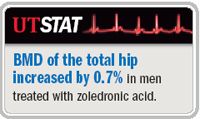Article
Refined bisphosphonate schedule may offer benefit
Author(s):
Atlanta-Bisphosphonates have already been shown to reduce loss of bone mineral density (BMD) in men undergoing androgen deprivation therapy and to reduce skeletal events and markers of bone turnover in men with metastatic prostate cancer. However, the drugs carry risks and can be expensive. That's why Dror Michaelson, MD, PhD, an assistant in medicine at Massachusetts General Hospital and instructor at Harvard Medical School, Boston, examined the effects of zoledronic acid (Zometa) in a once-annual dosing schedule that is much reduced compared with that used in past trials.

"There are some downsides to bisphosphonate therapy, so getting the right schedule is of great importance," Dr. Michaelson said during a presentation of his study findings at the American Society of Clinical Oncology annual meeting here.

At 12 months, mean BMD of the posteroanterior lumbar spine increased by 4.0% in the men treated with zoledronic acid and decreased by 3.1% in men who received placebo. BMD of the total hip increased by 0.7% in men treated with zoledronic acid and decreased by 1.9% in men who received placebo. These differences were statistically significant at both locations.
Levels of N-telopeptide, a marker of osteoclast activity, rose about 10% by the end of the study in the placebo group but dropped from 10% to 20% in the zoledronic acid group. Bone alkaline phosphatase levels, a marker of osteoblast activity, rose between 10% and 20% in the placebo group but dropped between 10% and 20% in the zoledronic acid group.
Important for future trials
Dr. Michaelson concluded that this annual schedule should be considered for men treated with GnRH agonists who are at risk of osteoporosis. GnRH agonists are known to decrease BMD and increase fracture risk in men with prostate cancer.
Nevertheless, some questioned whether an additional fracture risk of 6% to 8% was enough to prompt a change in practice, as that is a fairly modest event rate in cancer therapy. Dr. Michaelson responded that these results should help shape the design of future clinical trials rather than practice and noted that fracture prevention studies in non-metastatic prostate cancer are under way.
Dr. Tannock believed these results to be significant and the study large enough to recommend annual zoledronic acid as a treatment for those men who are at risk of osteoporosis as a result of GnRH agonist therapy.
He said that the study results are consistent with those of a number of others demonstrating benefit. In an open-label trial in men with hormone-sensitive prostate cancer and bone metastases, zoledronic acid, 4 mg every 3 weeks, also stopped bone loss and reduced markers of bone turnover (Urology 2005; 66:1054-9). Dr. Tannock also pointed out that in a trial by Saad and colleagues, zoledronic acid, 4 mg every 3 weeks, was reported to reduce skeletal events in men with hormone-refractory metastatic prostate cancer (J Natl Cancer Inst 2002; 94:1458-68).
















